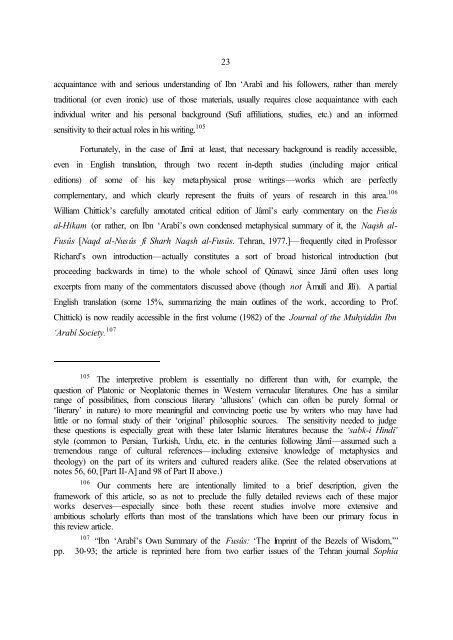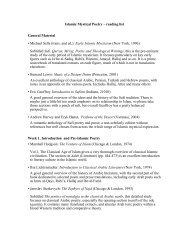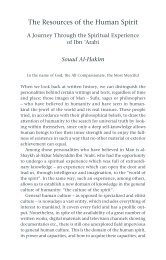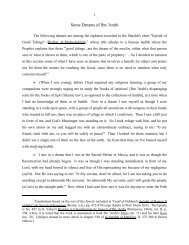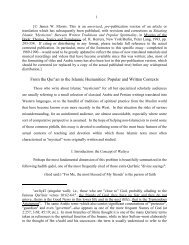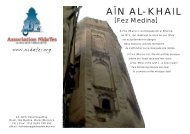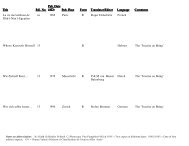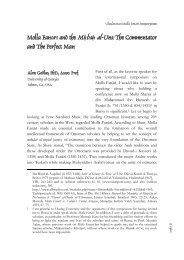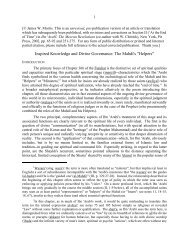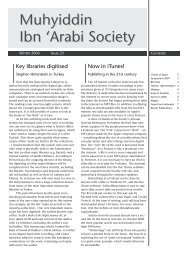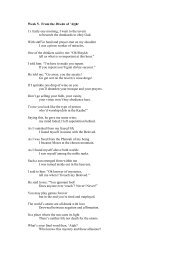Part III (pdf) - Muhyiddin Ibn Arabi Society
Part III (pdf) - Muhyiddin Ibn Arabi Society
Part III (pdf) - Muhyiddin Ibn Arabi Society
You also want an ePaper? Increase the reach of your titles
YUMPU automatically turns print PDFs into web optimized ePapers that Google loves.
23acquaintance with and serious understanding of <strong>Ibn</strong> ‘Arabî and his followers, rather than merelytraditional (or even ironic) use of those materials, usually requires close acquaintance with eachindividual writer and his personal background (Sufi affiliations, studies, etc.) and an informedsensitivity to their actual roles in his writing. 105Fortunately, in the case of Jâmî at least, that necessary background is readily accessible,even in English translation, through two recent in-depth studies (including major criticaleditions) of some of his key metaphysical prose writings—works which are perfectlycomplementary, and which clearly represent the fruits of years of research in this area. 106William Chittick’s carefully annotated critical edition of Jâmî’s early commentary on the Fusûsal-Hikam (or rather, on <strong>Ibn</strong> ‘Arabî’s own condensed metaphysical summary of it, the Naqsh al-Fusûs [Naqd al-Nusûs fî Sharh Naqsh al-Fusûs. Tehran, 1977.]—frequently cited in ProfessorRichard’s own introduction—actually constitutes a sort of broad historical introduction (butproceeding backwards in time) to the whole school of Qûnawî, since Jâmî often uses longexcerpts from many of the commentators discussed above (though not Âmulî and Jîlî). A partialEnglish translation (some 15%, summarizing the main outlines of the work, according to Prof.Chittick) is now readily accessible in the first volume (1982) of the Journal of the <strong>Muhyiddin</strong> <strong>Ibn</strong>‘Arabî <strong>Society</strong>. 107105The interpretive problem is essentially no different than with, for example, thequestion of Platonic or Neoplatonic themes in Western vernacular literatures. One has a similarrange of possibilities, from conscious literary ‘allusions’ (which can often be purely formal or‘literary’ in nature) to more meaningful and convincing poetic use by writers who may have hadlittle or no formal study of their ‘original’ philosophic sources. The sensitivity needed to judgethese questions is especially great with these later Islamic literatures because the ‘sabk-i Hindî’style (common to Persian, Turkish, Urdu, etc. in the centuries following Jâmî—assumed such atremendous range of cultural references—including extensive knowledge of metaphysics andtheology) on the part of its writers and cultured readers alike. (See the related observations atnotes 56, 60, [<strong>Part</strong> II-A] and 98 of <strong>Part</strong> II above.)106Our comments here are intentionally limited to a brief description, given theframework of this article, so as not to preclude the fully detailed reviews each of these majorworks deserves—especially since both these recent studies involve more extensive andambitious scholarly efforts than most of the translations which have been our primary focus inthis review article.107 “<strong>Ibn</strong> ‘Arabî’s Own Summary of the Fusûs: ‘The Imprint of the Bezels of Wisdom,’”pp. 30-93; the article is reprinted here from two earlier issues of the Tehran journal Sophia


